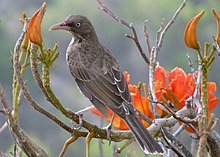Margarops
| Pearly-eyed thrasher | |
|---|---|
 |
|
| On Guana Island, British Virgin Islands | |
| Scientific classification | |
| Kingdom: | Animalia |
| Phylum: | Chordata |
| Class: | Aves |
| Order: | Passeriformes |
| Family: | Mimidae |
| Genus: |
Margarops P.L. Sclater, 1859 |
| Species: | M. fuscatus |
| Binomial name | |
|
Margarops fuscatus (Vieillot, 1808) |
|
| Subspecies | |
|
M. f. fuscatus (Vieillot, 1808) |
|
M. f. fuscatus (Vieillot, 1808)
M. f. densirostris (Vieillot, 1808)
M. f. klinikowskii Garrido & Remsen, 1996
M. f. bonairensis Phelps, Sr. & Phelps, Jr., 1948
The pearly-eyed thrasher (Margarops fuscatus) is a bird in the thrasher family Mimidae.
It is found on many Caribbean islands, from the Bahamas in the north to the Grenadines in the south, with an isolated population on Bonaire.
The pearly-eyed thrasher is the largest species in the Mimidae.
Its genus, Margarops, is considered monotypic today; formerly the scaly-breasted thrasher was placed here too. The present species, however, is now known to be closer to the Cinclocerthia tremblers.
There are four subspecies.
While this is not a migratory bird, considerable gene flow between populations appears to have taken place at least until fairly recently in its evolutionary history. At least two subspecies can be distinguished genetically: Margarops fuscatus fuscatus which is found between the Greater Antilles and Antigua and Barbuda, M. f. densirostris, occurring from Montserrat and Guadeloupe southwards. When exactly the pearly-eyed thrasher lineage diverged from its relatives cannot be said with reasonable certainty at the moment, as no fossils are known and the standard molecular clock model cannot be applied to the Mimidae as mutation rates seem to have varied over time.
...
Wikipedia

